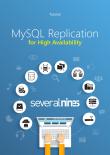blog
MySQL Replication: All the Severalnines Resources


MySQL Replication has become an instrumental part of scale-out architectures in LAMP environments. MySQL offers plenty of solutions when there is a need to scale out, the most common being to add read replicas.
Building a database HA stack for production can be daunting. It is not just about setting up replication between a master and some slave servers, it’s also about how to restore broken topologies and fail-over, how applications can keep track of the writable master and the read-only slaves, what to do when servers are corrupted, how to perform backups, and more.
We’ve produced a number of resources aimed at helping users to get started with MySQL Replication or to get more out of their existing setups.
The White Papers

The MySQL© Replication Blueprint
This is a great resource for anyone wanting to build or optimise a MySQL replication setup. The MySQL Replication Blueprint is about having a complete ops-ready solution from end to end. From monitoring, management and through to load balancing, all important aspects are covered.

MySQL Replication for High Availability
This whitepaper covers MySQL Replication with information on the latest features introduced in 5.6 and 5.7. There is also a hands-on, practical section on how to quickly deploy and manage a replication setup using ClusterControl.
The On-Demand Webinars
Top 9 Tips for Building a Stable MySQL© Replication Environment
MySQL replication is a widely known and proven solution to build scalable clusters of databases. It is very easy to deploy, even easier with GTID. However, ease of deployment doesn’t mean you don’t need knowledge and skills to operate it correctly. If you’d like to learn what is needed to build a stable environment using MySQL replication, then this webinar is for you.
Introducing the Severalnines MySQL© Replication Blueprint
The Severalnines Blueprint for MySQL Replication includes all aspects of a MySQL Replication topology with the ins and outs of deployment, setting up replication, monitoring, upgrades, performing backups and managing high availability using proxies as ProxySQL, MaxScale and HAProxy. This webinar provides an in-depth walk-through of this blueprint and explains how to make best use of it.
Managing MySQL Replication for High Availability
This webinar covers deployment and management of MySQL replication topologies using ClusterControl. We show you how to schedule backups, promote slaves and what the most important metrics are worth keeping a close eye on. We also demonstrate how you can deal with schema and topology changes and how to solve the most common replication issues.
Become a MySQL DBA: Schema Changes for MySQL Replication & Galera Cluster
Find out how to implement schema changes in the least impacting way to your operations and ensure availability of your database. This webinar also covers some real-life examples and discusses how to handle them.
Become a MySQL DBA: Replication Topology Changes for MySQL and MariaDB
Discover how to perform replication topology changes in MySQL / MariaDB, and what the failover process may look like. This webinar also discusses some external tools you may find useful when dealing with these operations.
Tutorials
MySQL Replication for High Availability – Tutorial
Learn about a smarter Replication setup that uses a combination of advanced replication techniques including mixed binary replication logging, auto-increment offset seeding, semi-sync replication, automatic fail-over/resynchronization and one-click addition of read slaves. Our tutorial covers the concepts behind our MySQL Replication solution and explains how to deploy and manage it.
Top Blogs
How to deploy and manage MySQL multi-master replication setups with ClusterControl 1.4
MySQL replication, while simple and popular, may come in different shapes and flavors. Master slave or master master topologies can be configured to suit your environment. ClusterControl 1.4 brings a list of enhancements to deploy and manage different types of MySQL replication setups. This blog outlines the different topologies that can be deployed, the merits of each topology, and shows how each can be managed in a live environment.
Automatic failover of MySQL Replication – New in ClusterControl 1.4
MySQL replication setups are inevitably related to failovers – what do you do when your master fails and your applications are not able to write to the database anymore? Automated failover is required if you need to quickly recover an environment to keep your database up 24×7. This blog post discusses this new replication feature recently introduced in ClusterControl 1.4.
Automating MySQL Replication with ClusterControl 1.4.0 – what’s new
This blog post will go through new replication features in ClusterControl 1.4.0, including enhanced multi-master deployment, managing replication topology changes, automated failover and handling of replication errors.
MySQL Replication failover: Maxscale vs MHA (A Four Part Series)
This series describes how you can implement automated failover with MariaDB MHA, how you can implement automated failover with MariaDB using Maxscale and MariaDB Replication Manager, how you can implement automated failover with MariaDB using Maxscale and MHA and compares the two with each other, and an addendum on the MariaDB Replication Manager covering the new improved
ClusterControl for MySQL Replication
ClusterControl provides advanced deployment, management, monitoring, and scaling functionality to get your MySQL replication instances up-and-running using proven methodologies that you can depend on to work. It makes MySQL Replication easy and secure with point-and click interfaces and no need to have specialized knowledge about the technology or multiple tools. It covers all aspects one might expect for a production-ready replication setup.
ClusterControl delivers on an array of features to help deploy, manage, monitor, and scale your MySQL Replication environments.
- Point-and-Click Deployment: Point-and-click, automatic deployment for MySQL replication is available in both community and enterprise versions of ClusterControl.
- Management & Monitoring: ClusterControl provides management features to repair and recover broken nodes, as well as test and automate MySQL upgrades. It also provides a unified view of all MySQL nodes across your data centers and lets you drill down into individual nodes for more detailed statistics.
- Automatic Failure Detection and Handling: ClusterControl takes care of your replication cluster’s health. If a master failure is detected, ClusterControl automatically promotes one of the available slaves to ensure your cluster is always up.
- Proxy Integration: ClusterControl makes it easy to build a proxy layer over your replication setup; it shields applications from replication topology changes, server failures and changed writable masters. With just a couple of clicks you can improve the availability of your stack.
Learn more about how ClusterControl can simply deployment and enhance performance here.
We trust that these resources prove useful!
Happy replicating!




